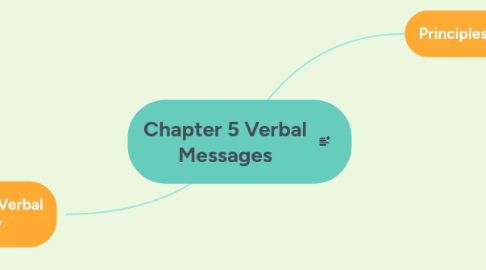
1. Principles of Verbal Messages
1.1. Meanings are in people
1.1.1. Meaning is determined by
1.1.1.1. Words
1.1.1.2. People
1.2. Messages are denotative
1.2.1. Dog”—domestic animal: a domestic carnivorous animal with a long muzzle,a fur coat, and a long fur-covered tail, whose characteristic call is a bark.
1.2.2. The meaning from the dictionary
1.3. Messages are connotative
1.3.1. The emotional meaning speakers and listeners give to a word
1.3.2. “Dog”—man’s best friend, loyal companion, playful and loving.
1.4. Messages can be onymous (signed messages)
1.4.1. “Signed”
1.4.2. Have an identified sender
1.4.3. Sender has to deal with message consequences
1.5. Messages can be anonymous (author not identified)
1.5.1. Author not known
1.5.2. Allows for open disclosure
1.6. Messages Vary in Directness
1.6.1. Indirect messages attempt to get the listener to say or do something without committing the speaker
1.6.2. Direct messages state more clearly the speaker’s preferences and then ask if the listener agrees
1.6.3. The advantages of indirect messages are the disadvantages of direct messages, and the disadvantages of indirect messages are the advantages of direct messages
1.7. Messages vary in abstraction
1.7.1. Messages and words can be very specific or very general
1.7.1.1. Liquid, Drink, Beverage, Carbonated, Soda, Coca-Cola™
1.8. Messages vary in politeness
1.8.1. Polite Messages
1.8.1.1. Reflect positively
1.8.1.2. Respectful
1.8.1.3. Less Direct
1.8.2. Impolite Messages
1.8.2.1. Attacking
1.8.2.2. Autonomous
1.8.2.3. More Direct
1.9. Messages vary in immediacy
1.9.1. Creation of closeness, togetherness, and oneness between the speaker and the listener
1.9.2. Immediacy behaviors (verbal and non-verbal) show:
1.9.2.1. Interest and attention
1.9.2.2. Admiration, respect, and attraction
1.9.3. Communicate immediacy by:
1.9.3.1. Self-disclosing
1.9.3.2. Acknowledging others
1.9.3.3. Finding common ground
1.9.3.4. Showing interest (verbally and nonverbally
1.9.3.5. Giving feedback
1.10. Messages Vary in Inclusion
1.10.1. Inclusive messages include all people present and they acknowledge the relevance of others.
1.11. Messages can deceive
1.11.1. not all messages or people are truthful
1.11.2. Types of Lies
1.11.2.1. Pro-social deception
1.11.2.2. Self-enhancement deception
1.11.2.3. Selfish deception
1.11.2.4. Anti-social deception
1.11.3. Behaviors Accompanying Lying
1.11.3.1. Liars hold back
1.11.3.2. Liars make less sense
1.11.3.3. Liars give a more negative impression
1.11.3.4. Liars are tense
1.12. Messages vary in assertiveness
1.12.1. Non assertive Messages
1.12.1.1. Does not express your true thoughts or needs
1.12.1.2. Gives into others without concern for yourself
1.12.1.3. Often requests permission from others when it is not needed
1.12.2. Aggressive Messages
1.12.2.1. Focus on yourself, not the other person
1.12.2.2. Shows little concern for others
1.12.3. Assertive Messages
1.12.3.1. Express your true thoughts
1.12.3.2. Are respectful of others
1.12.3.3. May disagree with the thoughts of others
1.12.4. Guidelines for Increasing Assertiveness
1.12.4.1. Analyze Assertive Messages
1.12.4.2. Rehearse Assertive Messages
1.12.4.3. Communicate Assertively
1.12.4.3.1. Describe the problem
1.12.4.3.2. State how the problem affects you
1.12.4.3.3. Propose workable solutions
1.12.4.3.4. Confirm understanding
1.12.4.3.5. Reflect on your own assertiveness
1.12.5. Confirmation and Dis confirmation
1.12.5.1. The extent to which you acknowledge another person
1.12.5.2. Confirmation
1.12.5.2.1. Acknowledges the other person’s presence and importance
1.12.5.2.2. Shows acceptance and respect of the person and relationship
1.12.5.3. Disinformation
1.12.5.3.1. Ignoring the other person and their communication
1.12.5.3.2. Denies the other person’s significance
1.12.6. Racism
1.12.6.1. Dis confirming
1.12.6.2. Negative attitudes or beliefs about specific races or ethnic groups
1.12.6.3. Institutionalized Racism
1.12.6.4. Racist Language
1.12.6.5. Avoid
1.12.6.5.1. Using derogatory terms
1.12.6.5.2. Using stereotypes
1.12.6.5.3. Referring to race when its irrelevant
1.12.6.5.4. Over attribution
1.12.7. Heterosexism
1.12.7.1. Attitudes, behaviors, and language that disparage gay and lesbians
1.12.7.2. The belief that heterosexuality is the “natural” form of sexual behavior
1.12.7.3. To be confirming
1.12.7.3.1. Avoid nonverbal mannerisms that parody stereotypes
1.12.7.3.2. Avoid comments like “you don’t look it” or “what a waste”
1.12.7.3.3. Avoid assumptions and over attribution
1.12.7.3.4. Acknowledge birthdays and anniversaries
1.12.7.3.5. Be inclusive of partners on invitations
1.12.8. Ageism
1.12.8.1. Discrimination, negative stereotypes, or disrespect based on age—young or old
1.12.8.2. To avoid ageism
1.12.8.2.1. Avoid talking down to older individuals
1.12.8.2.2. Refrain from refreshing an older person’s memory
1.12.8.2.3. Avoid implying relationships are no longer important
1.12.8.2.4. Speak at a normal volume
1.12.8.2.5. Engage all people in conversation
1.12.9. Sexism
1.12.9.1. Prejudicial attitudes or discrimination towards men or women based on gender roles
1.12.9.2. Sexist language
1.12.9.3. To avoid sexism
1.12.9.3.1. Avoid using the words man, he, and his generically
1.12.9.3.2. Avoid sex role stereotyping
1.12.10. Cultural Identifiers
1.12.10.1. Avoid racism, heterosexism, ageism, and sexism by referring to groups as they prefer to be called
1.12.10.2. Consider
1.12.10.2.1. Race and Nationality
1.12.10.2.2. Affectional Orientation
1.12.10.2.3. Age and Sex
